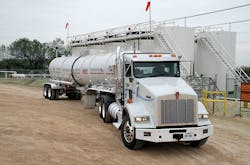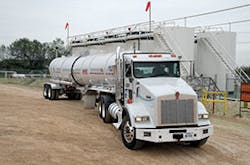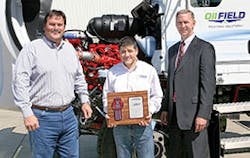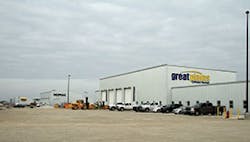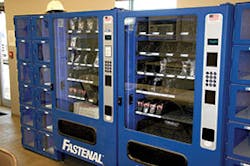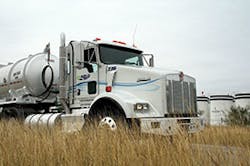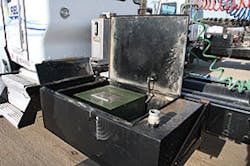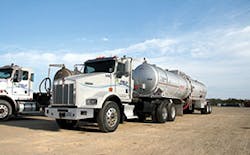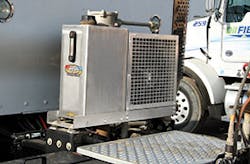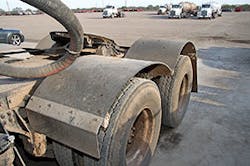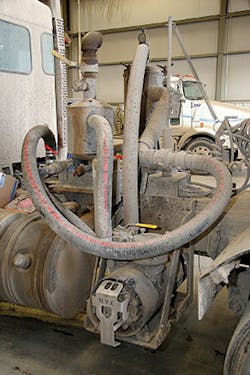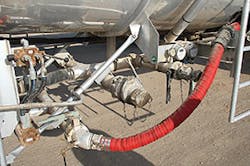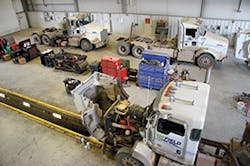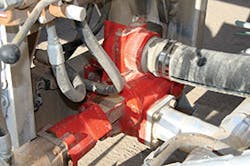Oilfield Trucking Solutions grows with shale plays across United States
FOR Chesapeake Energy Corporation and its affiliated companies, 2013 was a busy year and 2014 should bring even more activity. Chesapeake is the second largest producer of natural gas in the United States, and a top 11 producer of crude oil and natural gas liquids.
In the third quarter of 2013, Chesapeake Energy’s daily net crude oil production rose 23% year-over-year to 120,000 barrels per day, and natural gas liquids production was up 31% year-over-year for a total of 58,500 barrels per day. Over the course of 2013, the company averaged roughly 70 drilling rigs operating in oil and gas shale plays.
Oilfield Trucking Solutions (OTS) is one of the affiliates that was heavily involved in supporting the drilling and production operations. Acquired by Chesapeake Energy in 2009, the tank truck fleet hauls crude oil, condensate, water, drilling mud, and acids for its parent company. OTS operates 280 trucks in Texas, Oklahoma, Ohio, Pennsylvania, and West Virginia.
“Our operation saw significant growth in 2012 and 2013, and there is more growth coming in 2014,” says Christopher Broussard, president of Oilfield Trucking Solutions. “In January 2012, we were hauling 29,000 barrels of crude oil a day. We topped 80,000 barrels of crude oil a day in 2013, and we expect to add another 10,000 to 15,000 barrels a day in 2014.
“We haul about 40% of Chesapeake Energy’s liquids production, and that gives us plenty to do. We’ll handle the production increase over the next year with approximately the same number of trucks already in operation, but we probably will increase the number of drivers.”
Based in Oklahoma City, Oklahoma, OTS is part of Chesapeake Oilfield Services, which includes Performance Technologies, Hodges Trucking Co, Great Plains Oilfield Rentals, Compass Manufacturing, and Nomac Drilling. Trucks in the OTS fleet traveled several million miles over the past year in support of Chesapeake Energy’s drilling, well completion, and production operations.
The growth has been steady and sure since the trucking affiliate got its start almost a decade ago as a water hauler in the Marcellus shale play in Pennsylvania and West Virginia. Following its acquisition by Chesapeake Energy, the trucking affiliate expanded both the products hauled and its operating area.
On the water side, OTS transports process and flowback water generated by the drilling and hydraulic fracturing operations in Pennsylvania, West Virginia, Texas, Ohio, and Oklahoma. Water trucks are used in fluid containment during some fracking operations in the Marcellus. The fleet also offers disposal service of fracking fluids into permitted underground injection wells.
“We’ll have another busy year of water hauling in 2014,” Broussard says. “Despite slowdowns in the southern part of the Marcellus shale play, our operations in other areas are continuing to grow. We will also evaluate the possibility of moving water trucks into the Haynesville shale play (in eastern Texas and western Louisiana) in 2014.”
Oilfield Trucking Solutions p. 2...
Crude oil and condensate are hauled in Texas, Ohio, West Virginia, and Oklahoma. OTS transports hydrochloric acid for sister affiliate Performance Technologies for use in fracking operations and well completions in South Texas.
Texas—especially the Eagle Ford shale formation in South Texas—has become one of the most active areas for OTS and its parent company. “Currently, crude oil output across the entire Eagle Ford play is 900,000 barrels a day,” Broussard says. “Experts are projecting that output should peak at 1.6 million to 1.9 million barrels a day by 2016 at the earliest.”
He adds that OTS will be busy in South Texas for many years to come. “With producers moving to pad drilling, trucking is settling down somewhat in South Texas,” Broussard says. “Production companies are consolidating services, and they aren’t moving the drilling rigs as much. It’s still not as mature a field as the Permian Basin, and there are still plenty of liquid loads to haul.”
Shorter trips
Crude oil and condensate hauls are not as far today as they were a year ago. “Our average length of haul in the Eagle Ford today is just 30 miles due to infrastructure improvements,” Broussard says. “It was double that 18 months ago.”
Most of the OTS crude and condensate loads go to pipeline terminals. However, the fleet also hauls to a refinery in Three Rivers, Texas.
To keep the fleet rolling 24 hours a day, seven days a week, OTS employs 600 drivers. They work 12-hour shifts on a five-day week with a two/three days off schedule.
Oilfield truck driving is a physically demanding job. “One of our biggest challenges is making sure applicants understand that this is real work,” Broussard says. “In the Eagle Ford, for example, it’s hot for much of the year. Operations are in remote areas, and 70% of the driving is on dirt or gravel roads. Drivers must be able to think clearly and pay attention to what they are doing at all times.”
However, finding truck drivers who want to work in the oilfield hasn’t been particularly difficult for the OTS management team. “While there have been shortages in some areas, we are finding plenty of drivers,” Broussard says. “We run nice equipment, we pay well, and we offer good benefits. We stack up very well against the competition.”
He adds that the oilfield still is very attractive to drivers because they know they can make more there than in other areas of trucking. “There are plenty of drivers out there who really like oilfield work, and we have been very successful in attracting those individuals,” he says. “We’re seeing drivers with more oilfield experience and longevity.”
Increasingly, OTS recruits truck drivers who already live in the region where the company operates. To be considered for OTS, a driver must be at least 23 years old and have a minimum of one year over-the-road truck driving experience with a tractor-trailer rig. Water or crude hauling experience is preferred.
“We rarely hire people with the minimum experience, because we do have an ample supply of well-experienced candidates,” Broussard says.
New hire training starts with two weeks of classroom training that includes Chesapeake’s Stay Accident Free Everyday (SAFE) program, specific requirements of the OTS operation, and the Smith System of defensive driving. That is followed by three weeks of on-the-job training in the field with a company trainer.
The new driver’s performance is reviewed and critiqued throughout the training process, finishing with a field evaluation report. The report evaluates the proficiency and competency of a new driver.
Safety gets constant attention during and after the initial training. Safety meetings are held at least once a month with a focus on specific issues in the various regions where OTS operates. Drivers also receive refresher training as needed.
In coming months, drivers will be trained on the new tablet computers that will be used for dispatch, load status updates, and electronic ticketing. On-board equipment includes a blue tooth printer.
Oilfield Trucking Solutions p. 3...
Dispatchers will be able to monitor driver and vehicle status using OTS’s in-house developed application called Visual Transportation. The Chesapeake Oilfield Services IT team is working on an hours-of-service module that will include electronic driver logs.
For trucks and tractors, OTS runs a relatively young fleet of Kenworth T800s with extended daycabs. “Kenworth trucks are the predominant choice throughout Chesapeake Oilfield Services, and they have performed well for us,” Broussard says. “All of our tractors were purchased since 2011. We begin looking at replacement when a truck reaches 500,000 miles or five years. We work these trucks too hard to keep them indefinitely.”
OTS trucks are spec’d with 485-horsepower Cummins ISX15 engines. For transmissions, the company has been running Allison automatics, but 13-speed Eaton Fuller manual transmissions were selected for trucks that will be delivered in coming months.
OTS recently began testing a natural gas fueled truck. In August 2013, the company took delivery of the first Kenworth T800 powered by the new 400-hp Cummins Westport ISX12 G engine to come off the assembly line at Kenworth’s plant in Renton, Washington. The truck is fueled by compressed natural gas and is hauling crude oil in Oklahoma.
For driver comfort, OTS selects custom air-ride seats with seven-way adjustment. Trucks also are ordered with a package that includes extra insulation and sound-deadening features. Corner windows and larger door windows help ensure better all-round visibility.
Durability is a critical requirement for the trucks and tractors. OTS specifies 13,200-lb-capacity steer axles and three-eighths-inch steel frame rails, and the company plans to spec a tougher air suspension in the future.
“We plan to order the Hendrickson Primaax tandem air suspension on trucks we buy in the future,” Broussard says. “The oilfield is a harsh operating environment, and we need to run the toughest equipment we can buy.”
Tractors in crude and condensate service are equipped with centrifuges from W L Walker Co Inc or L-K Industries Inc. The centrifuges, which are used to test the specific gravity of crude oil, are installed in custom-built steel shake-out boxes from Calco Metal Works.
Tank trailersThe newest water-hauling trucks and tractors have Challenger vacuum pumps from National Vacuum Equipment. The system includes a noise-reduction muffler.
The tank fleet includes 130 200-barrel (8,400-gallon) crude oil trailers, 184 water tankers with capacities ranging from 90 to 130 barrels, and five fiberglass-reinforced plastic acid trailers.
Dragon is the primary supplier of 200-barrel aluminum crude oil trailers. Equipment includes Roper product pumps, Garnet level gauges, Civacon bottom-loading valves, Dixon Bayco hose couplings, and Scully grounding systems. OTS specifies Hendrickson Intraax and Watson-Chalin air suspensions.
Aluminum vacuum trailers with 130-barrel (5,400-gallon) capacity are used in Texas and Oklahoma. OTS runs 90- and 105-barrel (3,700- and 4,400-gallon) vacuum trucks in Pennsylvania, West Virginia, and Ohio.
Hydrochloric acid is transported in 5,500-gallon fiberglass-reinforced plastic tankers manufactured by Hawk FRP LLC. The filament-wound tank has a Derakane resin lining.
Maintenance program
An in-house maintenance program helps keep the fleet in top shape. “Approximately 98% of our fleet maintenance is performed in our own maintenance facilities,” Broussard says. “We have maintenance shops in Pearsall and Three Rivers, Texas, and Sayre, Pennsylvania. We are building a new 7,500-sq-ft shop in Cherokee, Oklahoma, and we have plans to build a maintenance facility in Ohio.”
OTS mechanics handle a majority of the truck maintenance, with the exception of major engine overhauls. Company mechanics handle routine service calls, including tire repairs and replacements. Shop equipment includes small trailers that are fully equipped to service trucks in the field.
Routine trailer maintenance is handled in-house, but code tank repairs and inspections are contracted out. Code tank shops used by OTS include the Wabash National Trailer Center and Alamo City Truck Service in San Antonio, Texas, and City Trailer & Paint Works in Oklahoma City, Oklahoma.
With the oilfield showing no signs of slowdown, the entire OTS operation will continue running hard. ♦
About the Author
Charles Wilson
Charles E. Wilson spent 31 years covering the tank truck, tank container, and storage terminal industries throughout North, South, and Central America as the editor of Bulk Transporter. Prior to 1989, Wilson was managing editor of Bulk Transporter and Refrigerated Transporter and associate editor of Trailer/Body Builders. Before joining the three publications in Houston TX, he wrote for various food industry trade publications in other parts of the country. Wilson has a bachelor's degree in journalism from the University of Kansas and served three years in the U.S. Army.
